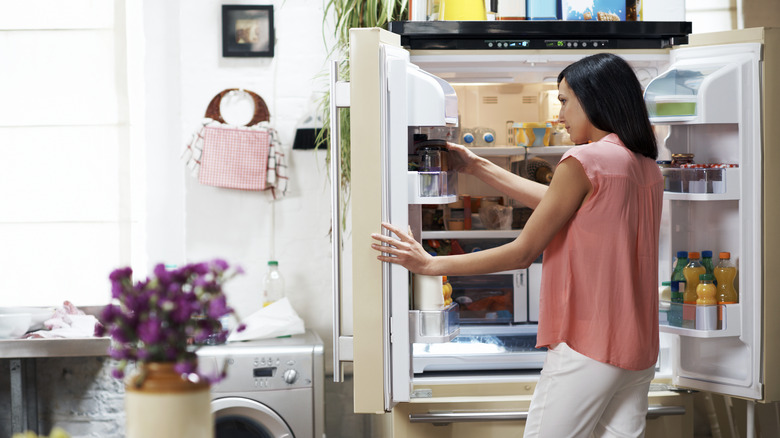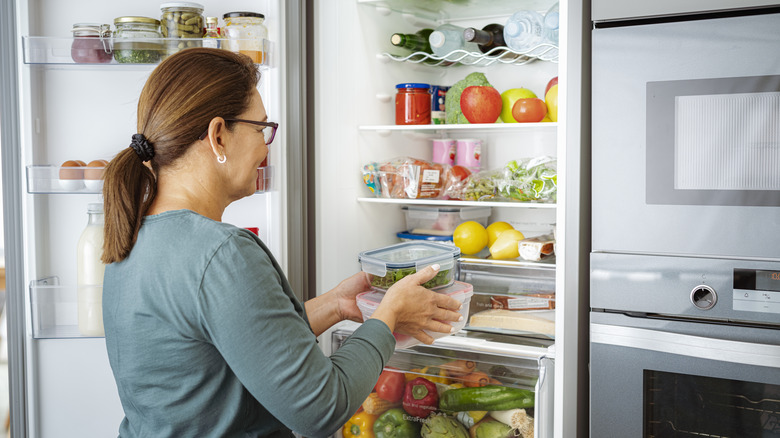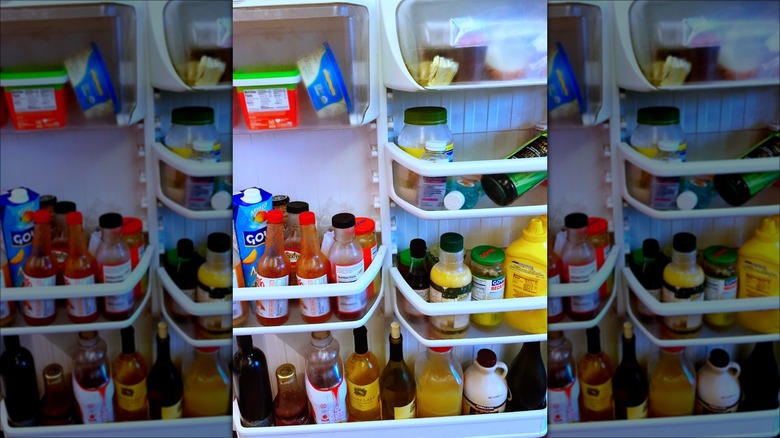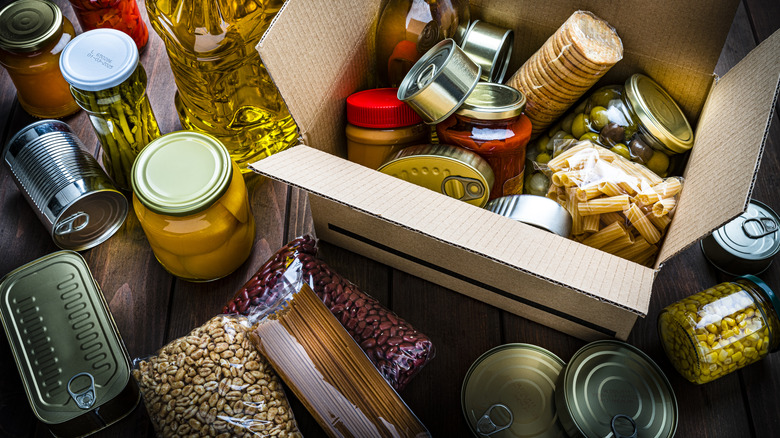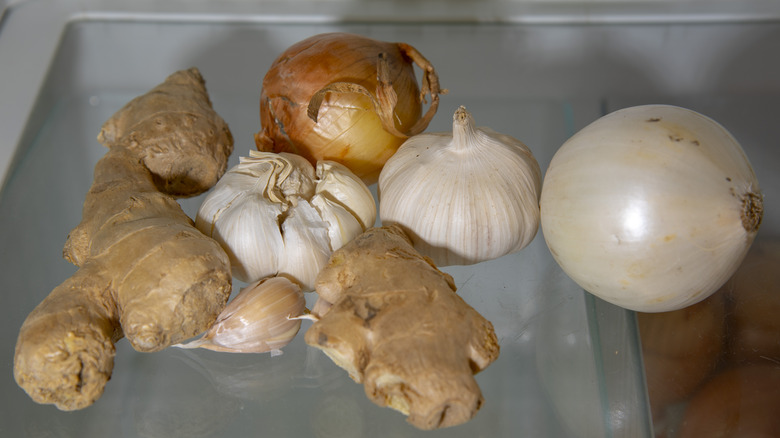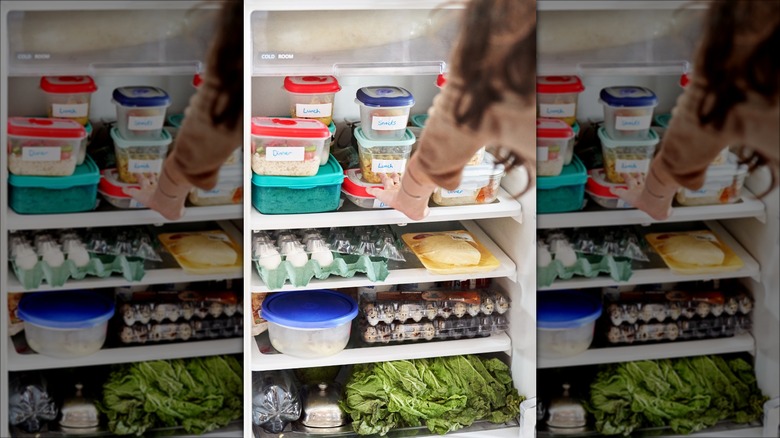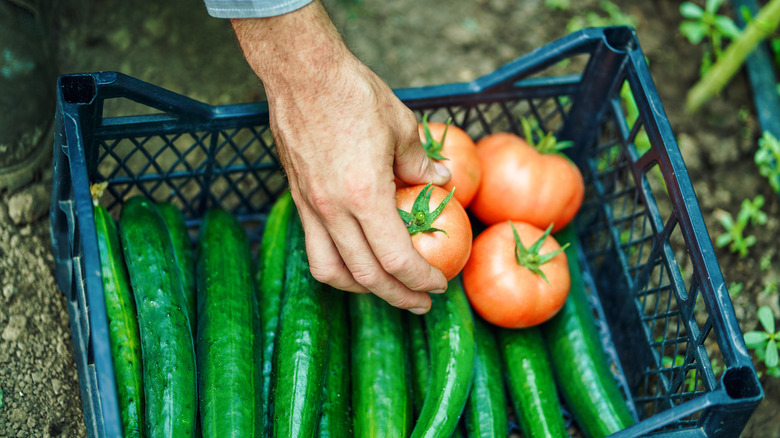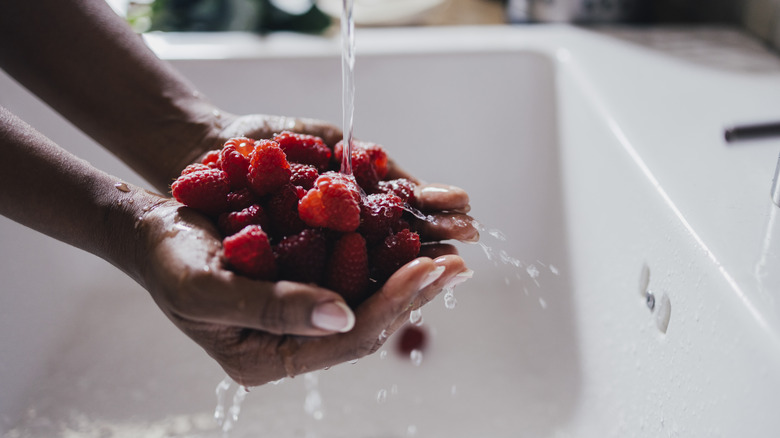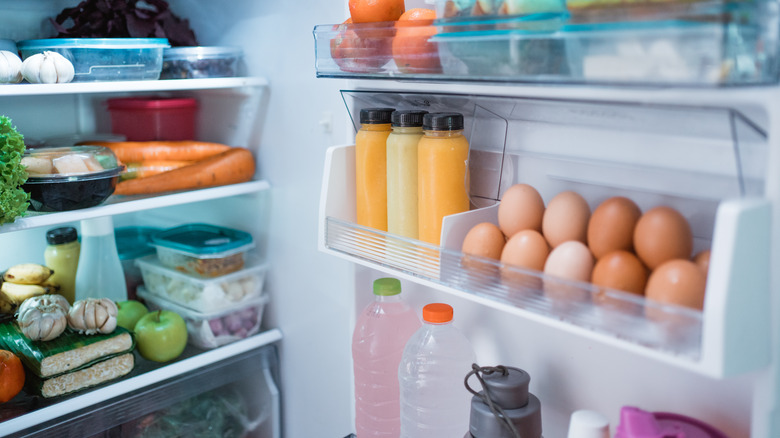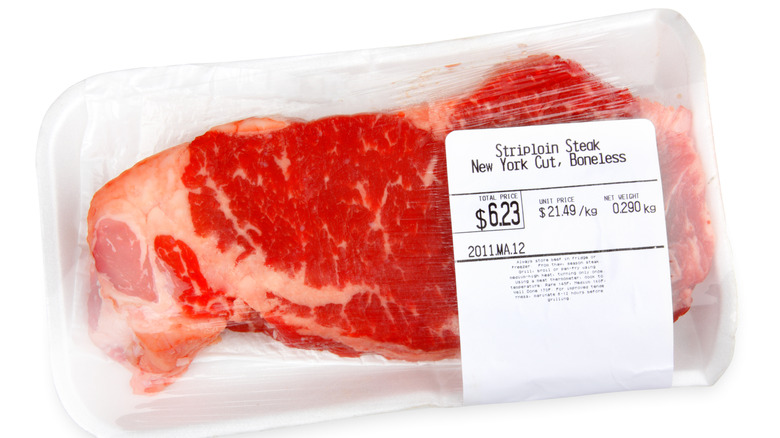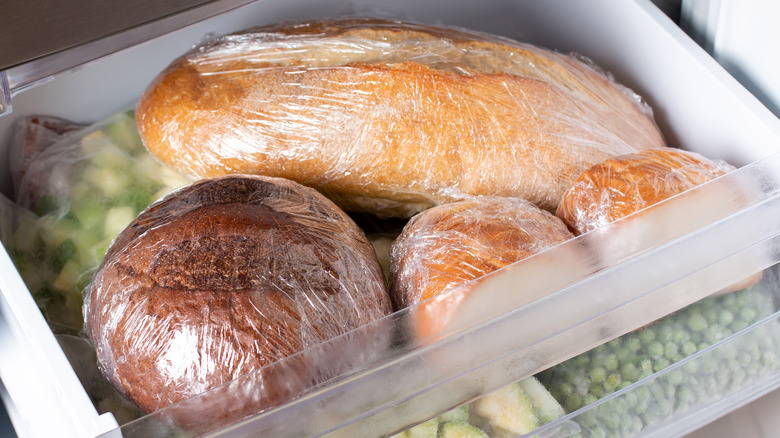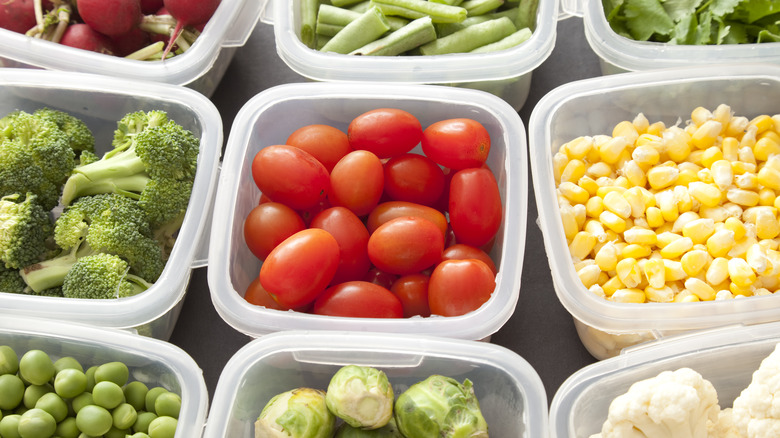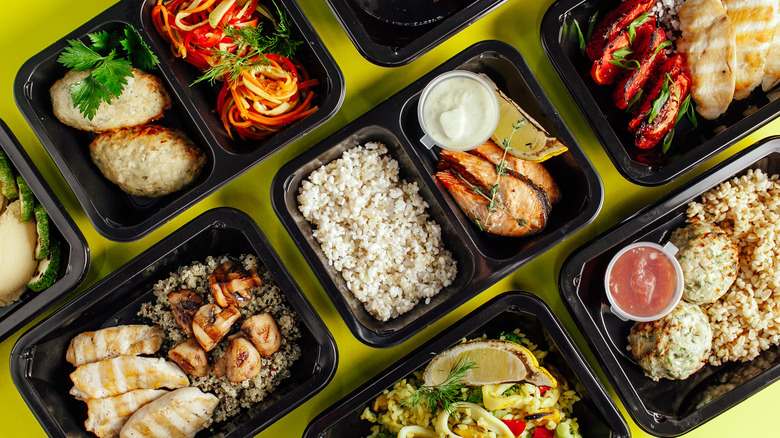Storage Mistakes That Are Ruining Your Food
When people finagle their way around the fridge, they often push and shove items out of the way to make room for tonight's dinner and perhaps the raw materials for lunch tomorrow. For those not in the know when it comes to food storage, it doesn't matter what order that food goes into the fridge — as long as it actually fits, it's all fine in the grand scheme of things. That line of thinking is fair enough. Food is at least going into the fridge, making it available for consumption another day.
However, learning how and where to store food in the fridge means that food lasts longer, tastes better, and is less likely to develop harmful bacteria that cause food spoilage and threaten cross-contamination. Some of these food storage pointers just make logical sense once you know the rationale behind them. Others help you make the best use of the space you have so that you have more room in the fridge. And some prevent you from wasting food by putting some systems in place that make you remember that you put potatoes in a plastic container less than a week ago.
The overall benefit of this, of course, is that your food lasts longer and goes to waste a lot less frequently. You'll save money, time, and possibly even your health by learning how to store your food in the refrigerator the proper way. And here are several places to start.
Stashing food haphazardly on the fridge shelves
If you look at your refrigerator as a unit of cold and colder, you're probably not getting the complete picture. The reality is your refrigerator is many shades of cold, with the freezer being the coldest part. Your refrigerator door is among the warmest spots, making it an ideal place for condiments like ketchup, mustard, and soy sauce. Stuff that is going to go the way of the dodo very quickly should go right in the center of the fridge where you won't forget about it. If you still feel like you might miss something, lazy Susans help you organize your fridge and allow you to see everything that you have with just the turn of a wrist.
Meat and fish like the bottom shelf, but there is a problem with that. These foods often drip juices which will ruin the fruits and vegetables in your crisper unless you take steps to avoid this. Your best bet with this is to store them in containers with lids. Anything that's going to leak out will leak out into the container and not into your fresh fruits and veggies.
And speaking of the crisper, there's a reason it's called that. It's meant to keep your fruits and vegetables crisp and fresh until you're ready to eat them, so be sure to store them there.
Storing condiments in the fridge
Here's a secret about condiments that's hiding in plain sight. Most of them are made from ingredients that naturally preserve food — think vinegar, sugar, and salt, and you have the right idea. Or they are fermented. Examples of this would be Worcestershire sauce and soy sauce. This means that you don't have to put them in the refrigerator door after opening if you don't want to. They'll remain viable even if you stash them in the cupboard.
If you find that you perpetually run out of space in the fridge, this one act could open up at least a tiny bit of space in the refrigerator door where most people store their condiments. This opens up the space to store plenty of other cool items, like jellies, jams, and cold drinks.
Some home gourmands even advocate putting fresh vegetables in the door and the condiments in the crisper. The rationale behind this is that it's easy to forget vegetables in the crisper, leaving most people with black, rotting vegetables. Switching these items around lessens the likelihood that the vegetables will go bad before you can eat them. If you hate the idea of putting your condiments in the pantry on the shelf but you'd like to have a little bit more efficiency in your fridge, this might be a good option.
Leaving food in the can it came in
Everyone has probably heard some version of this food storage no-no. You should never store food in the fridge in the can that it came in. The reasons are many. Some people worry about the metal corroding into acidy foods like tomatoes, or Bisphenol-A, or BPA making its way into the contents of the food.
In the former case, this could be a danger, but it would take several years for conditions to be right enough for that to happen. And the latter case, results are inconclusive right now. It's a situation that the Food and Drug Administration (FDA) is monitoring, but it's an ongoing thing. Currently, with what the FDA knows, the levels that might be found in packaging aren't deemed to be harmful.
So if these concerns are fairly close to being just urban legends, then why all the fuss about storing food in the refrigerator in the can that it came in? The answer is something that die-hard food nerds can get behind. Storing this food in a covered glass container just makes it taste better when you get ready to eat it. If you put it away like this, you can count on it being good for three or four days in the refrigerator before you should throw it out. The lid keeps the food from drying out so that it tastes as fresh as possible when it comes time to cook with it.
Putting onions in the fridge
Want to know the quickest way to make your onions soggy and mushy? Here's a hint: put them in the fridge. And if you've always done this, you've been storing your onions the wrong way for your whole life.
Chemistry comes into play here. The extreme cold of the fridge is like a factory that transforms the starches in the onion into sugar. This, in turn, makes them mushy and soggy. Onions are the type of vegetable that likes just mild cool, with a little dry air, and maybe a mesh bag to nap in. If you have a space like that in your pantry, it'll be like a cozy vacation for your onions, who will sleep there happily until they actually become your onion rings.
Once you cut into an onion, it's then okay to store it in the fridge until you're ready to eat or use the rest of it. Stashing it in a sealable bag or an airtight container offers you the best bet for keeping it fresh until that time comes.
Hanging on to leftovers past their expiration date
If you're the type of person who treats everything of value like it's precious, you may want to change this stance when it comes to your leftovers. In this case, it's best to seize the day, or the leftover roast chicken, as the case may be, and eat it up before the end of the fourth day. In other words, your leftovers will stay good in the refrigerator for less than a week before you need to toss them. Keeping them any longer than that means you're inviting in harmful bacteria, molds, or fungi which ultimately spoil your food and potentially can make you sick.
Ideally, those leftovers went into the fridge within two hours of the time they finished cooking. Waiting for too long after that puts you in the danger zone, which means your food is coming in at temperatures of 40 F to 140 F. At those temperatures, your glass cookware becomes a beaker of science experiments that smell good but will make you oh so sick.
If you know that you can't eat them within three or four days, put the leftovers into the freezer, where they will keep for several months. Not everything freezes beautifully. If your food looks worse after freezing it, you've probably made a mistake somewhere in the freezing process.
Chilling out tomatoes and cucumbers
Tomatoes and cucumbers, one of the great couplings in saladland, and ideally, the cukes come in crisp and the tomatoes are meaty and substantial. And they will be those things if they're stored right. For cucumbers, it's all about not sweating it. When cukes sweat in the fridge, that's when they get mushy. They like the warmer parts of the fridge, like the door. Unlike many fruits and veggies, which shouldn't be rinsed before refrigerating them, cucumbers should be at least rinsed slightly. Once that's done, wrap your cucumbers in a paper towel to keep the condensation off of them. Put them in plastic, like a plastic bag or a sealable plastic container with a lid.
Tomatoes require a little bit of TLC to stay fresh. Tomatoes that aren't fully ripe can hang out on the counter for a couple of days. After the days are over, it's going to be up to you to decide whether you want to refrigerate them or not. There are arguments for both sides. Some say to never refrigerate your tomatoes because they turn mealy. Of course, the only exception to this would be after you've cut into the tomato. Then you can refrigerate it.
Other tomato lovers maintain that you can refrigerate a tomato after ripening it. In this case, it may come down to personal preference. If you like chilled tomatoes, find a spot for them in the fridge. If you don't, well don't.
Washing fruits and veggies before refrigerating
It's natural to want to wash your fruits and vegetables to ensure that any dirt, grime, or even pesticides get washed off before you eat them. This impulse isn't wrong. However, the timing of when you wash the fruit or vegetable might be less than optimal. Extra moisture, in the form of the dampness from the wash, creates the possibility that your fruit or vegetable will rot before you can eat it, since moisture speeds up this process.
It's for this reason that when you wash your fruits and vegetables, it should be done directly before you plan on eating them. Anywhere from a couple of minutes to an hour before eating, would be ideal.
However, if you feel it's an affront to your fresh produce to put it in the fridge without washing it, then there may be a few ways around this bit of advice that you can try. If you wash fresh fruits, like berries, then put them into a paper-towel-lined salad spinner and spin until all of the extra moisture is completely flicked away. The dryer you can make the freshly-washed produce, the better. You don't want water droplets on the produce.
Another option is the vinegar solution trick. Wash delicate fruits like berries in one cup of vinegar and three cups of water. Then put them into the salad spinner lined with a paper towel to dry. Store in the fridge as usual.
Using the door for egg storage
Relatively speaking, the fridge door is among the warmest places in your refrigerator, which means that foods, like eggs, that require a bit more chill factor don't get the coldness they need to remain viable in the fridge. The constant opening and closing of the refrigerator doesn't keep the eggs consistently cold (or anything else in the door, for that matter).
Instead, do your eggs a big favor by stashing them in the back of the chill-it box in the container they came in works best. A temperature of 40 F keeps your eggs at their finest. It's also a bad idea to keep the cracked eggshells in the carton they came in. Once the eggs get washed during production, any protective coating comes off, leaving the porous eggs vulnerable to bacteria and other contaminants, including yucky smells that are lurking on the cracked shells and in the fridge at large. Finally, store the eggs narrow-side down. They stay fresher longer when you do that.
Ignoring meat storage best practices
Cross-contamination is a real thing, and as such when you're storing meat in the refrigerator, it's imperative that you make sure that the meat is both cold enough and doesn't leak juices from its package. Otherwise, your refrigerator becomes ripe for cross-contamination of different bacteria from the meat.
The first thing you want to do is to set aside some space on the bottom shelf above the crisper. This counts among the coldest places in the refrigerator and your raw meat, like chicken, ground beef, or steak, will remain viable for longer in these temperatures.
Next, stash the raw meat in plastic bins inside the fridge. You can leave it in its absorbent meat packaging, but that packaging has a tendency to allow the juices of the meat to leak out. And it'll leak into your fruits and vegetables in the crispers. By storing it in the additional plastic containers with a lid you ensure that it doesn't leak into the crispers below, and you also additionally reduce the possibility of cross-contamination with other items in the fridge. The smell of the meat will be less likely to taint the other food in the fridge, or not as easily because it's sealed in a plastic bin with a lid. Finally, keep the meat at around 40 F. That keeps it chilled, allowing you to preserve the meat for as long as possible.
Keeping bread in the fridge
Bread going bad in the fridge has largely to do with chemistry and geometry, more or less. The flour has starch granules that contain molecules that form themselves into a certain kind of geometrical structure. Water breaks apart the crystalline nature of this geometrical structure until, on the molecular level, there is no structure to speak of.
However, once the cooling starts again, the geometry in the bread's crystalline structure forms again. This process happens over and over, with the crystalline structure tearing down and building up the starch again, depending on how exposed to the cold the bread is. Putting the bread in the fridge interferes with the process, causing the bread to eventually go stale and dry out faster than if you stored it in a place, like the bread drawer or bread box, which is a bit more bread-friendly.
And on a related note, very often bakery bread likes paper bags better than it likes plastic. Once it's stashed in plastic, it opens up the possibility of it sweating. This can introduce the possibility of molding, particularly if, when you take the bread out of the fridge, you decide to store it on top of the fridge instead.
Leaving food uncovered
When you're tired and just want to put food in the fridge after dinner, it can be tempting to just shove it into the icebox without a lid. And you get bonus laziness points if it goes into there in the pot you cooked it in. All kidding aside, there's a big danger that comes with putting food in the fridge without a lid. It becomes ripe for cross-contamination.
Here's how. Juices and drippage from food containers can spill down into the uncovered food and introduce germs and bacteria into anything below it that's living in the fridge sans covering. All it takes is a little jostling of the food containers above the open bowl or container to introduce contaminants into the mix.
On a related note, if the taste of the food can be tainted by the other food around it, leaving food without a lid increases the likelihood that the taste of one food will seep into another food unintentionally due to the food hanging out in the fridge without a lid.
Choosing the wrong containers for food
Who knew that Tupperware and its generic equivalents came with so many storage rules? But they do, and breaking these often unspoken rules means that you end up with food that's inedible for all the reasons.
Here's just a small sampling of what's meant by all of this. You put food in an opaque container, which opens up the risk of the food going bad because you can't see the contents. This, in turn, makes you forget about the food. Or what about this one? You should only use one-time-use containers, like water bottles, just once. Many water bottles take on bacteria after you drink out of them, making them unsafe to refill and use again.
The same principle lies behind the idea of putting your food into food-grade containers before putting them into the fridge. This type of container is less likely to be filled with things that might harm your health, like plastic molecules. Aside from all of this, even the best of containers, like the Tupperware brand, break down over time, making them less safe or even practical to use.
One simple way to avoid this is to store food in glass containers with lids. This ensures that you're not using plastic you can't see through or plastic that has started to break down, allowing your food storage methods to be healthier.
